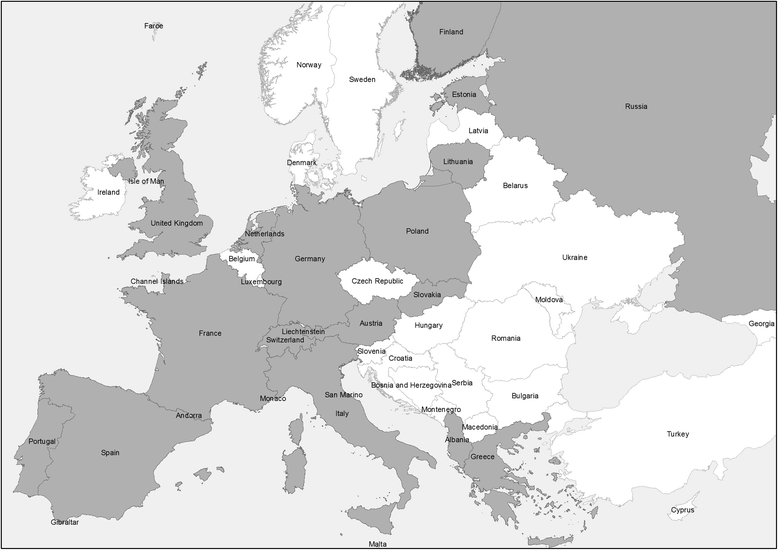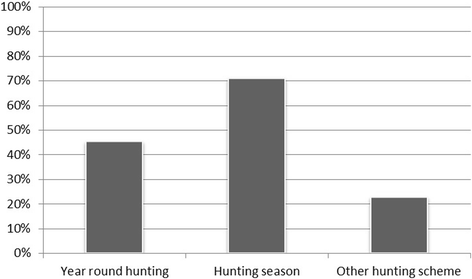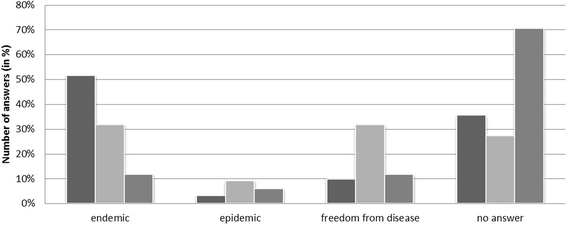Harmonizing methods for wildlife abundance estimation and pathogen detection in Europe-a questionnaire survey on three selected host-pathogen combinations
- PMID: 28202055
- PMCID: PMC5312528
- DOI: 10.1186/s12917-016-0935-x
Harmonizing methods for wildlife abundance estimation and pathogen detection in Europe-a questionnaire survey on three selected host-pathogen combinations
Abstract
Background: The need for wildlife health surveillance as part of disease control in wildlife, domestic animals and humans on the global level is widely recognized. However, the objectives, methods and intensity of existing wildlife health surveillance programs vary greatly among European countries, resulting in a patchwork of data that are difficult to merge and compare. This survey aimed at evaluating the need and potential for data harmonization in wildlife health in Europe. The specific objective was to collect information on methods currently used to estimate host abundance and pathogen prevalence. Questionnaires were designed to gather detailed information for three host-pathogen combinations: (1) wild boar and Aujeszky's disease virus, (2) red fox and Echinococcus multilocularis, and (3) common vole and Francisella tularensis.
Results: We received a total of 70 responses from 19 European countries. Regarding host abundance, hunting bags are currently the most widely accessible data source for widely distributed mid-sized and larger mammals such as red fox and wild boar, but we observed large differences in hunting strategies among countries as well as among different regions within countries. For small rodents, trapping is the method of choice, but practical applications vary among study sites. Laboratory procedures are already largely harmonized but information on the sampled animals is not systematically collected.
Conclusions: The answers revealed that a large amount of information is available for the selected host-pathogen pairs and that in theory methods are already largely harmonized. However, the comparability of the data remains strongly compromised by local differences in the way, the methods are applied in practice. While these issues may easily be overcome for prevalence estimation, there is an urgent need to develop tools for the routine collection of host abundance data in a harmonized way. Wildlife health experts are encouraged to apply the harmonized APHAEA protocols in epidemiological studies in wildlife and to increase cooperation.
Keywords: Animal abundance; Diagnostic methods; Europe; Harmonization; Questionnaire; Wildlife.
Figures





Similar articles
-
Combining information from surveys of several species to estimate the probability of freedom from Echinococcus multilocularis in Sweden, Finland and mainland Norway.Acta Vet Scand. 2011 Feb 11;53(1):9. doi: 10.1186/1751-0147-53-9. Acta Vet Scand. 2011. PMID: 21314948 Free PMC article.
-
Effects of culling Eurasian wild boar on the prevalence of Mycobacterium bovis and Aujeszky's disease virus.Prev Vet Med. 2012 Dec 1;107(3-4):214-21. doi: 10.1016/j.prevetmed.2012.06.001. Epub 2012 Jun 27. Prev Vet Med. 2012. PMID: 22743215
-
Aujeszky's disease in red fox (Vulpes vulpes): phylogenetic analysis unravels an unexpected epidemiologic link.J Wildl Dis. 2014 Jul;50(3):707-10. doi: 10.7589/2013-11-312. Epub 2014 May 7. J Wildl Dis. 2014. PMID: 24807353
-
Pseudorabies virus in wild swine: a global perspective.Arch Virol. 2011 Oct;156(10):1691-705. doi: 10.1007/s00705-011-1080-2. Epub 2011 Aug 12. Arch Virol. 2011. PMID: 21837416 Review.
-
Ecology and epidemiology of Echinococcus multilocularis in Europe.Parassitologia. 2006 Jun;48(1-2):37-9. Parassitologia. 2006. PMID: 16881392 Review.
Cited by
-
How to Start Up a National Wildlife Health Surveillance Programme.Animals (Basel). 2021 Aug 30;11(9):2543. doi: 10.3390/ani11092543. Animals (Basel). 2021. PMID: 34573509 Free PMC article.
-
Identifying maintenance hosts for infection with Dichelobacter nodosus in free-ranging wild ruminants in Switzerland: A prevalence study.PLoS One. 2020 Jan 9;15(1):e0219805. doi: 10.1371/journal.pone.0219805. eCollection 2020. PLoS One. 2020. PMID: 31917824 Free PMC article.
-
Development of Reporting Guidelines for Animal Health Surveillance-AHSURED.Front Vet Sci. 2019 Nov 27;6:426. doi: 10.3389/fvets.2019.00426. eCollection 2019. Front Vet Sci. 2019. PMID: 31828080 Free PMC article.
-
Local rabies transmission and regional spatial coupling in European foxes.PLoS One. 2020 May 29;15(5):e0220592. doi: 10.1371/journal.pone.0220592. eCollection 2020. PLoS One. 2020. PMID: 32469961 Free PMC article.
-
Analysis of a European general wildlife health surveillance program: Chances, challenges and recommendations.PLoS One. 2024 May 21;19(5):e0301438. doi: 10.1371/journal.pone.0301438. eCollection 2024. PLoS One. 2024. PMID: 38771857 Free PMC article.
References
-
- Kuiken T. Establishing a European network for wildlife health surveillance. Rev Sci. 2011;30:755–61. - PubMed
-
- European Wildlife Disease Association (EWDA). 2016. Available from: www.ewda.org. Accessed Apr 2016.
-
- Coordination of European Research on Emerging and major Infectious Diseases of Livestock. 2016. Available from: http://era-platform.eu/. Accessed Apr 2016.
-
- Harmonised approaches in monitoring wildlife population health, and ecology and abundance. 2016. Available from: http://www.aphaea.org/. Accessed Apr 2016.

